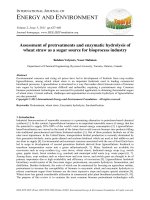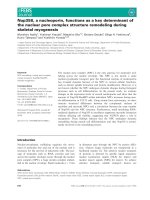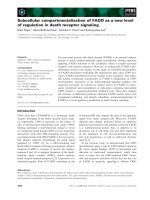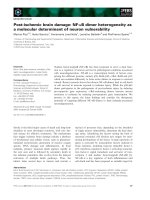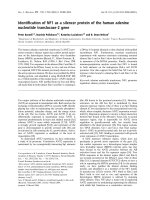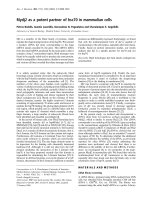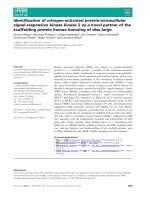Spent coffee grounds as a versatile source of green energy
Bạn đang xem bản rút gọn của tài liệu. Xem và tải ngay bản đầy đủ của tài liệu tại đây (3.31 MB, 15 trang )
Spent Coffee Grounds as a
Versatile Source of Green Energy
Scientific Seminar
Le Ngoc Hoang Anh
th
Hanoi,
Hanoi, 05
05th Octorbor
Octorbor 2020
2020
OUTLINE
0
1
0
2
0
3
0
4
2
INTRODUCTIO
N
MATERIALS AND
METHODS
RESULTS AND
DISCUSSION
CONCLUSION
INTRODUCTION
However, biodiesel is more
expensive than fossil fuels.
Biodiesel is a good alternative for fossil
fuel.
3
INTRODUCTION
Coffee powder
Beverage
Brewed
Coffee powder waste
Extraction with hexane/ether
Triglycerides
Solid waste
Glycerin
Biodiesel
4
Ethanol
Fuel pellets
Figure 1. Schematic representation of the biodiesel production process from
spent coffee grounds. The other value-added products such as H2, ethanol,
and fuel pellets can also be achieved from this waste feedstock
MATERIALS AND
METHODS
Oil Extraction
5
Transesterification Process
Characterization
MATERIALS AND METHODS
Oil Extraction
Refluxed
Filtered
(Buckner funnel)
Separated
FFAs
6
Separated
(rotary evaporator)
characterized & quantified
(HPLC)
MATERIALS AND METHODS
Transesterification
Process
7
MATERIALS AND METHODS
Characterization
The yield and composition of the biodiesel were
investigated using HPLC (High performance liquid
chromatography)
8
RESULTS AND DISCUSSION
A small amount of FFA,
monoglycerides (MG), and
diglycerides (DG) was also observed
in the oil.
9
Figure 2. HPLC chromatogram of the oil extracted from spent coffee grounds
indicating the presence of TG, a small amount of DG, MG, and FFA.
10
RESULTS AND DISCUSSION
Source
Advantage
Disadvantage
Tallow, brown
grease, pork fat
(white grease),
lard, fish oil,
poultry fat
Animal fat oxidative stability,
less expensive
High sulfur content, high FFA (50%90%) bad odor, bad cold flow
properties, high cloud point, high pour
point, transportation costs, purification
required
Used
Used vegetable
vegetable
oil
oil
Vegetable
Vegetable oil
oil less
less expensive,
expensive,
readily
available
readily available
Bad
Bad ofor,
ofor, high
high FFA
FFA
Less expensive, higher
Less
expensive,
higher
stability,
well-established
stability,
well-established
transportation,
pleasant
transportation,
pleasant
smell
smell
Extraction of oil from spent coffee
Extraction
of oil from spent coffee
grounds required
grounds required
Coffee oil
Coffee oil
Amount (million
gallons/year)
2.92
2.92
Table 1. Comparison of Coffee Oil with Other Waste Feedstock for Biodiesel Production
The quality of the coffee oil as feedstock for biodiesel production was a better quality and cost-effective
as compared to other waste sources available to date .
11
RESULTS AND DISCUSSION
GC-MS analysis showed the presence
of C18-C16 methyl esters of fatty acids,
where more than 99% of the total
composition was methyl esters of palmitic
acid (51.4%), linoleic acid (40.3%), and
stearic acid (8.3%).
Figure 3. GC analysis of the biodiesel shows the different methyl esters of fatty acids present
in the biodiesel produced from the used coffee grounds. The presence of various methyl
esters in coffee biodiesel obtained by MS is shown in the inset table (spectra not shown).
12
RESULTS AND DISCUSSION
The analysis of the results shows
that biodiesel obtained from spent
coffee grounds is a strong candidate
as an alternative to diesel.
Table 2. ASTM Results for the Coffee Biodiesel
1
RESULTS AND DISCUSSION
Coffee grounds could still be used as compost
for the garden and/or as fuel pellets.
A profit of more than $8 million/year, if both
biodiesel and pellets can be marketed.
14
CONCLUSION
-
≈ 15% of the oil obtained from spent coffee grounds was converted to biodiesel with 100% yield.
-
Spent coffee grounds can be used as a potential source to produce quality biodiesel and fuel
pellets, this biodiesel can be used industrially as an alternative to diesel.
Spent coffee ground
THANK YOU!
15
ANY QUESTION?

